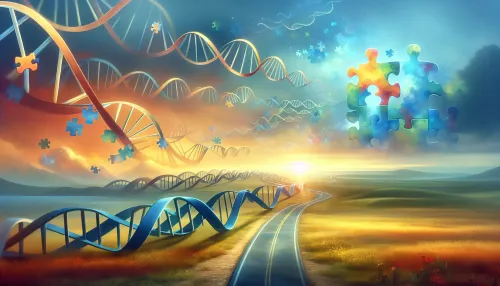Precision in Paintbrush Strokes: A Scientific Approach to Nurturing Artistic Talents in Autistic Children

Art has long been recognized as a powerful tool for self-expression and skill development. For autistic children, engaging in visual arts can be especially beneficial, offering a platform for creativity and expression. However, it's crucial to approach artistic training with a scientific lens, ensuring that the process is tailored to the specific needs of autistic individuals.
Cultivating Cognitive Precision through Visual Arts Training
When cultivating cognitive precision through visual arts training for autistic children, it's essential to merge creativity with structured teaching methods. By doing so, we can create an environment that fosters artistic growth while addressing the unique cognitive characteristics of autism.
Every stroke of a paintbrush or pencil mark on a canvas is an opportunity for autistic children to develop their fine motor skills and express their creativity. To achieve this, it's vital to strike a balance between technical precision and creative freedom in art education. This approach allows autistic individuals to explore their artistic abilities while also honing their attention to detail and precision.
Incorporating the formula of merging technical precision with creative freedom in fine arts empowers autistic talents to express themselves while developing crucial skills that enhance their overall cognitive abilities.
The Formula for Fine Arts: Balancing Precision and Creativity
Autism-specific art programs play a significant role in enhancing fine motor skills while promoting creativity among autistic children. The incorporation of scientific rigor ensures that these programs are tailored to address the unique needs of individuals on the autism spectrum.
By fostering a journey from expressionism to exactitude, these programs provide a structured yet nurturing environment where autistic children can explore various art forms, ultimately contributing to the refinement of their fine motor skills and cognitive development.
Related Article: Charting the Unseen Spectrum: Advancements in Neuroimaging for Autism Understanding
Enhancing Fine Motor Skills with Autism-Specific Art Programs
Artistic abilities among autistic individuals vary widely, ranging from painting and drawing to sculpting and digital art. Leveraging data-driven approaches allows educators and caregivers to identify and enhance specific artistic abilities within the realm of autism education.
By recognizing the diverse spectrum of skills present in autistic individuals, educators can tailor art programs to cater to individual strengths, providing a personalized approach that amplifies the artistic talents of each child.
Utilizing Data-Driven Approaches in Autism Education
Precision-oriented practice plays a pivotal role in fostering attention to detail and spatial awareness in autistic artists. Through science-informed techniques, educators can create structured exercises that emphasize precision while nurturing spatial awareness among autistic children engaged in artistic pursuits.
By incorporating science-informed techniques into practice sessions, educators can empower autistic artists to refine their attention to detail and spatial cognition, laying the groundwork for further artistic growth and development.
Amplifying focus and coordination is essential for the artistic growth of autistic individuals. Carefully designed art activities that emphasize accuracy not only promote focus but also contribute to the refinement of motor coordination skills among autistic children.
Related Article: The Genetic Enigma of Autism: Elucidating the Role of DNA in ASD
Fostering Attention to Detail and Spatial Awareness
By providing opportunities for precise brushwork or meticulous drawing exercises, educators can support the development of focus and coordination, nurturing the artistic talents of autistic individuals through targeted interventions grounded in scientific methodologies.
In conclusion, precision in paintbrush strokes involves merging scientific approaches with artistic expression to create a tailored environment for nurturing the talents of autistic children. By infusing art education with structured yet creative methodologies informed by data-driven insights, we can empower autistic individuals to explore and refine their artistic abilities while fostering cognitive growth and development. The fusion of scientific precision with artistic freedom paves the way for a vibrant journey where every stroke on the canvas becomes an avenue for creativity and cognitive enrichment.
Frequently Asked Questions
Art serves as a powerful tool for self-expression and skill development in autistic children. Engaging in visual arts fosters creativity while offering a structured environment that addresses their unique cognitive characteristics, ultimately enhancing their overall cognitive abilities.
Educators can enhance artistic abilities in autistic individuals by leveraging data-driven approaches to identify specific strengths. Tailoring art programs to cater to these individual talents allows for a personalized educational experience that amplifies each child's artistic potential.
Precision-oriented practice is crucial for autistic artists as it fosters attention to detail and spatial awareness. By incorporating science-informed techniques into art education, educators can create structured exercises that enhance these skills, supporting the overall artistic growth of autistic individuals.
Check Out These Related Articles

Unveiling the Link Between Gut Health and Autism Spectrum Disorder

Collective Genius: Mapping the Future of Autism Care With Crowdsourced Data

Paving Pathways: Geneticists Uncover Advances in Understanding Autism's Genetics
